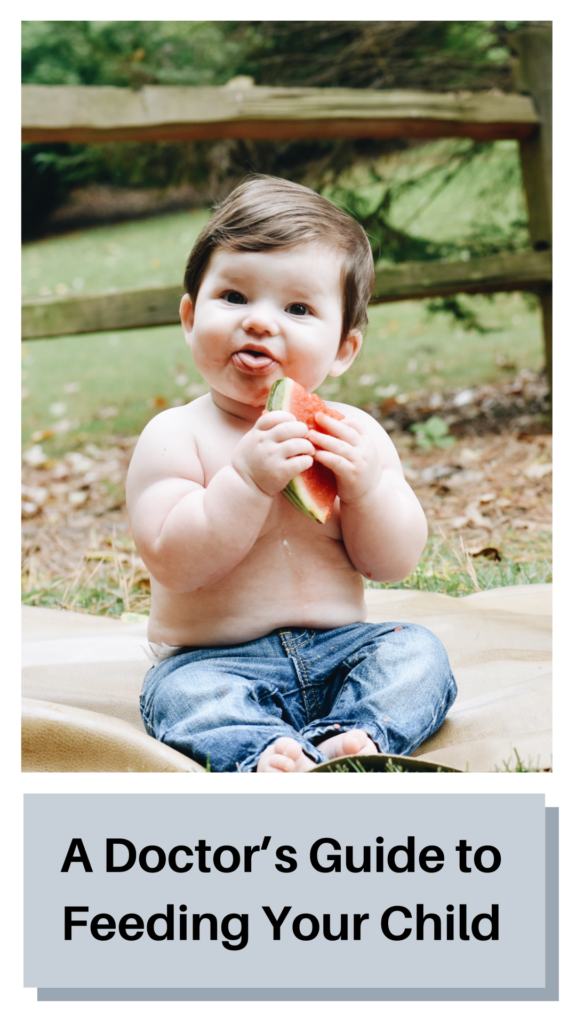Feeding children can be intimidating and anxiety provoking. Here are some tips that I wish my patients knew about feeding their children!

Each food group has it’s own tips and tricks to introduce the flavors, and textures, in a safe and appetizing way.
FRUIT

Many children naturally love fruits. With the juicy sweet qualities they are natural treats. The key to fruit is ensuring you cut pieces properly so they don’t become a choking hazard.
Tips:
- Strawberries- remove stem and cut in half lengthwise.
- Round berries (blue berries, raspberries, etc)- smash
- Grapes- cut into quarters (I recommend a grape cutter)
- Watermelon- cut long strips for baby to hold
- Oranges- offer slice without peel
- Banana- cut peel down to create handle for baby to hold
If your child does not naturally gravitate towards fruit alone as a snack, try offering different ways. Fruits are the perfect addition to smoothies, yogurt, and baked goods!
AAP recommendation:
- 2-2.5 cups of fruit per day
- No juice for babies under 1yr, and MAX of 4oz per day of pure 100% juice for children over 1yr.
VEGETABLES

Due to their firm texture and low sugar content children often do not automatically gravitate to vegetables the way they do fruits.
Tips:
- Have them precut and readily available for snacks and to add to meals. Always offer prior to the sweet treat snack.
- Offer in very small amounts and eat them along with your child.
- Add to favorite dishes. For example- spinach in spaghetti or scrambled eggs, peas with Mac n’ cheese, lettuce in tacos, carrots in soup, and broccoli in fettuccine Alfredo.
- Experiment with different textures and temperatures. For example- one night serve cooked peas, the next frozen or refrigerated.
- Offer dips the child enjoys such as ranch, ketchup, or cheese.
- To decrease the risk of choking offer hard vegetables to babies in cooked form (able to squish with fingers). Steam or sauté to approximately soften.
- Spiralized vegetables and long-finger-width size work well for early toddlers. While older toddlers may enjoy the crunch from shredded raw veggies.
- Toddlers truly eat with their eyes first. Arrange the snack in a cute design.
- MY FAVORITE TIP: RENAME the vegetable. For example, Broccoli= Unicorn trees, Carrots= Paw Patrol rockets. Take what your child loves and name the food accordingly.
AAP Recommendation:
1-2 yrs- 1/2 cup/day
2-3 yrs old- 1 cup/day
4-8 yrs old- 1.5 cups/ day
9+ yrs old- 2 cups/ day
PROTEIN

Protein comes in many different forms; from dairy to eggs, beans to nuts/legumes, and of course meat or tofu. Protein is an important part of the diet for building muscle and sustaining daily energy levels.
Many people are nervous about offering potential allergens such as nuts, but research has shown early exposure to be ideal (unless concerns for significant risk).
Tips:
- Nut butters are excellent added to oatmeal, toast, baked goods, fruit, and yogurt. Avoid whole nuts until after 4yrs old (when risk of chocking decreases).
- Beans can be puréed, added to baked goods, cooked in soup or chili, scrambled into eggs, melted into a quesadilla, or served alone.
- Eggs are a great place to experiment with texture, flavors, and temperature. One option is to offer omelettes with various fillings cut into strips.
- For early eaters ground or shredded meats are easier to chew. Be aware that large pieces of beef may be tough leading to risk for chocking. Think softly cooked meats, the key is moisture.
- Tuna and low mercury fish are wonderful shredded or cut into strips for easy grasping.
- Hummus, greek yogurt, mashed back beans, and cottage cheese, all make great dips.
- Seafood including shellfish may be offered as long as there is no significant family history of allergies.
*** If you have any concerns about potential food allergy PLEASE speak to your Pediatrician to discuss further. ***
AAP Recommendation:
1-2 yrs- /day
2-3 yrs old- 2 oz /day
4-8 yrs old- 3 oz / day (approx 19g)
9+ yrs old- 5 oz / day (approx 34g)
Adolescents 14-18yr needs depends on gender. Boys 52g, Girls 46g
Examples:
1 Ounce= 1 egg, 1 Tbsp nut butter, 1/4 cooked beans or peas
Excess protein can cause health concerns. Unless instructed by your pediatrician do not supplement your child with protein powders.
GRAINS

For many families grains are a staple of daily meals. Rice, oatmeal, toast, cereal, quinoa, and Pasta. The list of options is numerous. Grains have the potential to offer a great source of fiber while being the perfect medium to mix delicious veggies and protein into your child’s diet.
Tips:
- Offer whole grains when possible.
- Offer wide variety of grain types to limit arsenic exposure.
- Experiment with various seasonings, sauces, and fillings.
- Consider offering at different temperatures. Cool noodles or a totally different sensory experience then warm ones.
- Offer noodles of different shapes. Spiral and tube shaped pasta’s are often easier for young children.
- Rice and quinoa may be difficult for young babies to pick up. Consider offering on a loaded spoon.
- Pasta dishes are the perfect place to offer puréed or well cooked veggies to picky eaters.
- Thin strips of toast is a great vehicle for nut butters, smashed avocado, and fruit.
- Pancakes are delicious with fruit added in.
AAP Recommendations:
1-2 yrs old 1-2 oz/day
2-3 yrs old- 3 oz/day
4-8 yrs old- 4 oz/day
9+ yrs old- 5 oz/day
Example:
1 Ounce= 1 slice of bread, 1/2 cup of cooked rice, pasta or cereal


Dr. Patricia Bast was born and raised in Southern California. She earned a bachelors degree in science at UC Irvine, then went on to graduate medical school from Touro University College of Osteopathic Medicine in Northern California. After several years working as a pediatrician Dr. Bast choose to expand her training to include lactation consultant. Dr. Bast is now raising her children and taking care of patients in beautiful Georgia.